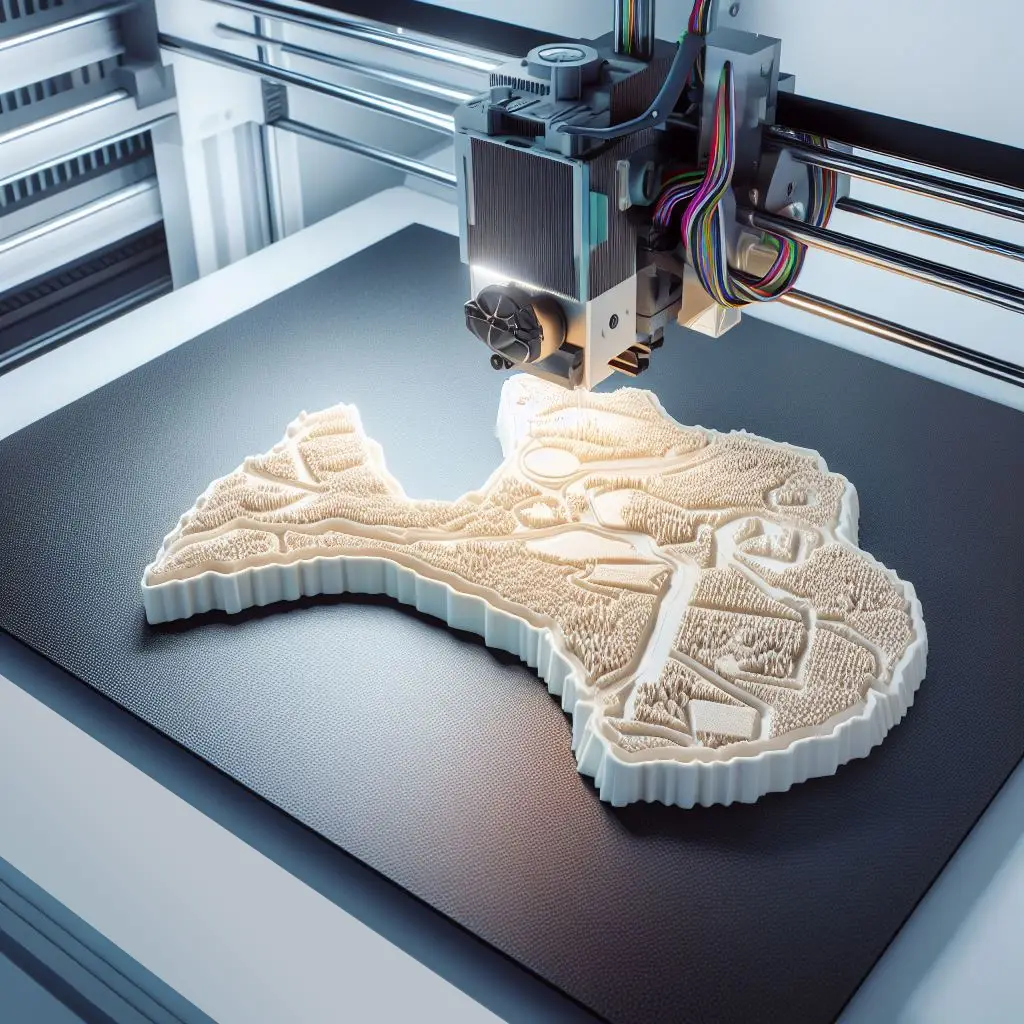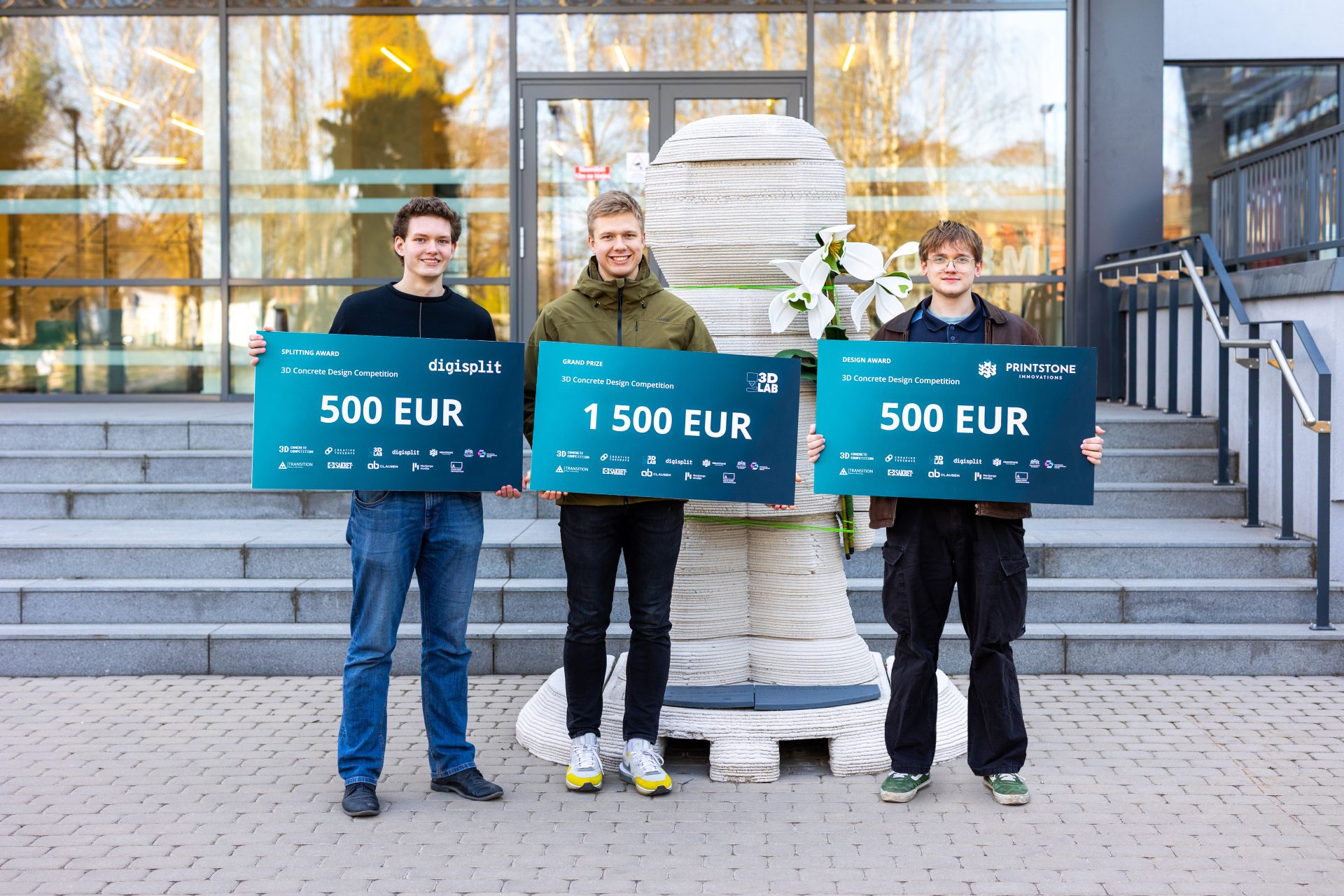Transforming Waste Into High-Performance 3D Printable Cementitious Composite
The project aims to develop a ready-to-use blend of components with a large proportion of oil shale ash suitable for various types of extrusion 3D printers whose mechanical resistance and durability are validated on a large-scale prototype.

About 3D Printable Cementitious Composite
About project
The objective of the project Transforming waste into high-performance 3D printable cementitious composite (TRANSITION) is to develop a high-performance cementitious composite which repurposes a large proportion of oil shale ash and is suitable for extrusion-based additive manufacturing (3D printing) of full-scale structural elements and buildings.
The main result of the project is a precisely balanced pre-blended mixture of dry components with a reduced environmental impact. When mixed with water, the mixture forms a plastic mass that can be pumped and extruded then it hardens into a rock-like composite with the serviceability required for concrete structures.

Main activities and results
The project is structured in six work packages.
WP1: Project Management and Dissemination
- Project management and coordination.
- Dissemination of project findings and information.
WP2: Component Selection, Characterization, and Pre-treatment
- Selection of components for the composite material.
- Characterization of chosen components.
- Oil shale ash collision milling.
- Formulation of the sustainable pre-blended dry product.
WP3: Admixtures for Setting and Property Manipulation
- Development and testing of admixtures for manipulating the setting properties.
- Investigation of how admixtures affect mechanical and durability properties.
WP4: Printability Assessment and Small-Scale Prototype Design
- Development of a methodology for assessing the printability of the composite material.
- Design and creation of a small-scale prototype.
WP5: Large-Scale Prototype Printing and Composite Performance
- Printing a large-scale prototype using the composite material.
- Demonstrating the performance of the composite in the large-scale prototype.
WP6: Life Cycle Assessment (LCA) and Composite Optimization
- Conducting Life Cycle Assessments (LCAs) and Life Cycle Cost Assessment (LCCA) at major project iterations.
- Using LCA findings to optimize the composite material.
- Final assessment of the large-scale prototype’s sustainability.
Our Partners
Partners that participate in the project
Institutions and companies from 3 different EU countries participate in the project - Latvia, Lithuania and Slovenia. The project has 3 academic partners and the company, dry mix producer.
Riga Technical University
Role in the project
RTU as Project coordinator, will lead the project and General Assembly, which will be established for the strategic planning and direction of the project. Its role is to decide on high-level management issues, mainly technical, financial, exploitation, dissemination, planning, and control matters. The main tasks will be the management of research data; dissemination activities of project results; management of IPR and RRI implementation. RTU will contribute to the high-energy milling of the oil shale ash. RTU will create durability test methods for 3D printed concrete and perform these tests, as well as work on the printability and mechanical resistance of the composite. RTU will make a 3D-printed prototype about 3 × 3 × 1.5 m in size and demonstrate its performance in a relevant environment; and will also provide data and participate in the calculation of Life Cycle Assessment (LCA) and Life Cycle Cost Assessment (LCCA).
Relevant expertise
RTU has experience in the development of a wide range of innovative technologies that can be used to design and construct more energy-efficient, sustainable, and accessible materials with low CO2 emissions. More than ten projects regarding the development of novel building products were realized in the last six years. Rational use of natural resources and recycling of waste materials are the main objectives of the scientific projects of RTU. Also, the work with concrete research and testing has always been topical at RTU, much experience has been accumulated in the use of various additives in the development of ultra-high-performance concrete, and there is ongoing cooperation with the industry in conducting various concrete tests. RTU has well-equipped scientific laboratories – gantry type 3D printer with various mixers and pumps, equipment for the preparation of mixtures, determination of fresh mixture properties, as well as of hardened properties using hydraulic presses, climatic chambers. Also, instrumental methods for material characterization are available (SEM, Micro-tomography, EDX, XRD, etc.). RTU also has software and experience in LCA development. The scientific team consist of the project leader (leading researcher, male), main executor (leading researcher, male), researcher (PhD student, female) and scientific assistant (PhD student, male).
Added value
RTU has experience in managing research projects of this size, and in the dissemination of results, which will be an added value as a project manager. Also, RTU will supplement the project with its experience in grinding raw materials with collision milling, which will help to make high-performance composites using a large amount of oil shale ash. 3D printing experience with a gantry-type printer will provide added value for this type of printing and the application of the new material with it.
Kaunas University of Technology
Role in the project
KTU is responsible for the characterization of the rheological, mechanical and durability properties of the 3D printed mixture. Targeted properties will be tailored through the particle size distribution of dry components and the selection of admixtures. The high-frequency ultra-sonic dispersion will be tested to see the effect on targeted characteristic properties. Will contribute to the project management activities and design of the large-scale prototype. It will also contribute to the dissemination activities, in particular to scientific publications and conference presentations.
Relevant expertise
Contributes to the consortium a comprehensive range of specialists and state-of-the-art equipment such as high-frequency ultra-sonic dispenser, scanning electron microscope, semi-adiabatic calorimeter, rheometer, mercury intrusion porosimeter, self-made 3D printer.
The research team will be led by a young doctor (less than 10 years after being awarded a PhD), consists of 3 scientists (1 senior research, and 2 young researchers) and 1 junior researcher (PhD student) with a background in civil engineering, material science, knowledge in developing dry mixtures recipes, specialists in durability (especially in frost resistance), rheology properties of concrete.
Added value
Interpretation of rheological properties of 3D printed concrete, mechanical properties and resistance to frost damage. Recommendations on how to properly use chemical admixtures and high-frequency ultra-sonic dispenser in order to control the setting process and obtain the best mechanical and durability properties.
Slovenian National Building and Civil Engineering Institute
Role in the project
Responsible for the characterization of dry components, for developing the methodology for printability assessment and for its evaluation, for verification of structural integrity of printed structures and for the LCA and LCCA assessments, will contribute to the formulation of the pre-blended dry product, tailoring of rheological, mechanical and durability characteristics of the composite, to design and fabrication of a large-scale prototype and to the dissemination activities, in particular to scientific publications, workshops and conference presentations.
Relevant expertise
Contributes to the consortium a wide range of state-of-the-art equipment such as microCT, scanning electron microscope, isothermal calorimeter, laser analyzer, rheometer and robotic station for 3D printing, along with skilled operators.
The research team, led by a young doctor (less than 10 years after being awarded a PhD) consists of six scientists with a background in geology, karstology, civil engineering, material science, nanoscience and nanotechnology with competencies in cement-based composites, material characterization, material formulation, 3D printing, rheology, durability and LCA.
Added value
Interpretation of material characterization results, formulation of pre-blended dry product, methodology for printability assessment, structural integrity verification of the composite, LCA and LCCA interpretation.
SAKRET, Ltd.
Role in the project
Development of the mixtures based on their previous expertise in dry-mix formulation, as well as work done so far on 3D printable dry mixtures. SAKRET’s general role is also to supply the oil shale ash from the power plant in Estonia. SAKRET will be involved in producing the samples and performing mechanical testing of the mixtures. The partner has a significant role in large-scale prototype production because the production and placement of the prototype itself for long-term testing will be the responsibility of SAKRET, RTU will provide the design of the prototype and print it. Also, all dissemination activities related to the prototype will be the responsibility of SAKRET. SAKRET will also manage the acquisition of all input information for LCA and LCCA. As the main user of the scientific results of the project, the role of SAKRET will be the commercialization of results.
Relevant expertise
SAKRET is a leading building materials producer in Baltic countries with more than 19 years of experience in the construction sector specializing in the production of dry and ready-to-use construction mixes. SAKRET operates in 3 Baltic countries with 3 dry mix and 1 liquid mix factory, owns 4 laboratories for product testing and new product development, runs a distribution center in Finland. SAKRET has developed and owns more than 150 original product recipes with high added value, ensuring a full range of building materials from concrete, masonry mortars, and plasters to complex systems e.g. warm insulation, tiling, and self-levelling mixtures. All SAKRET products and product systems are compliant with the highest quality standards, have a CE mark, and are certified by competent institutions. Constantly working on new product development, SAKRET professional team has accumulated expert-worthy experience, received different awards in the Baltic States and Scandinavia for the production of innovative materials and export development.
The scientific team consist of the project leader (leading researcher), main executor (chief technologist), researcher and technologist.
Added value
SAKRET owns three dry-mixture plants in each of the Baltic states, thus being able to successfully compete in the local building materials market and also export abroad. One of the benefits of SAKRET’s participation in this project is access to this infrastructure, as the factory’s production line will not require any improvements to produce the intended dry-mixtures, thus making efficient use of existing resources. The second benefit and contribution is the know-how on the development of new dry-mixtures, as it is one of the main functions of SAKRET technologists, so this knowledge and laboratory equipment will be used to achieve the project goals. The benefit and contribution can also be mentioned in the existing sales channels, as SAKRET is a well-established network of building material wholesalers, this network can also be used for the materials developed in this project, as logistics and financial guarantees are provided by wholesalers and distributed through their retail channels.
Work packages
WP breakdown
The detailed breakdown of the six work packages by task can be seen below
- WP1
Project Management and Dissemination
- Implement Project Management Methodology (PM2) to effectively deliver project outcomes.
- Disseminate project results to stakeholders, in particular students, professionals and researchers.
Task 1.1
Project management activities. Organize the kick-off meeting to initiate the execution of the project. Organize monthly meetings of the Steering Committee and biannual General Assembly review meetings. Manage the research datasets. Coordinate activities and resources, resolve problems and monitor the quality and timeliness of the activities. Organize the project-end review meeting.
Task 1.2
Dissemination activities. Execute the dissemination activities.
- WP2
Sustainable Pre-Blended Dry Product
Formulate the composition of the sustainable pre-blended dry product suitable for extrusion 3D printing, having a balanced mechanical resistance, durability and environmental footprint.
Task 2.1
Characterization and pretreatment of solid constituents. Characterization tests such as reactivity, particle size distribution, morphology and texture identification will be performed.
Task 2.2
Oil shale ash collision milling. The high-energy collision milling will be implemented to reduce the particle size of oil shale ash and thus improve its reactivity. Milling parameters will be optimized to achieve optimal particle size distribution. A sufficient quantity of oil shale ash will be processed.
Task 2.3
Formulation of the pre-blended dry product. Use characterization data to formulate the composition of the pre-blended dry product for 3D printing with a substantial proportion of oil shale ash. The fine granular composition of oil shale ash obtained through the high-energy collision milling will enable the formulation of the composite material with high packing density.
- WP3
Tailoring Composite Properties
Optimize the composite formulation by balancing printability, mechanical resistance and durability requirements.
Task 3.1
Rheological properties. Tailor rheological properties of the composite in the fresh, plastic state to achieve suitable printability. The focus will be on cohesiveness and thixotropic behavior. Rheological parameters will be assessed with a rotation-oscillation type rheometer and/or other methods as found appropriate. The rheological properties will be tailored through the particle size distribution of dry components and the selection of admixtures. The high-frequency ultrasonic dispersion will be tested to speed up the setting of the filament.
Task 3.2
Mechanical properties. Mechanical properties will be tailored to achieve an optimal balance between the strength of the composite and the strength of the interlayer bond. Grinding of oil shale ash is expected to contribute to strength through improved reactivity. The targeted compressive strength of the composite is 40 MPa. In addition to compressive tests, the indirect tensile test will be conducted.
Task 3.3
Durability. Durability will be tailored firstly by manipulating the particle sizes of oil shale ash and secondly by manipulating the overall particle size distribution of the dry product to achieve high packing density and, thus, lower water permeability. Density, water absorption and freeze-thaw test will be conducted.
- WP4
Small-Scale Prototype
Assess the printability of pre-blended material and mechanical resistance of printed structure by the means of small-scale prototypes.
Task 4.1
Methodology for printability assessment. The methodology for the assessment of printability will be defined. It will specify the geometric features and tolerances that should be achievable with different printers. A printability ranking matrix will be established. It will serve as a basis for distinguishing mixes suitable for printing. The prototype, which includes all geometrical features defined in the methodology, will be designed in CAD software (e.g. Fusion or Rhino).
Task 4.2
Printability evaluation. Small-scale prototypes will be fabricated with at least two different printers. The printability of the mix will be assessed according to the methodology defined in task 4.1. – the defined features will be measured and evaluated against the tolerances and the printability score will be determined from the ranking matrix. The score will indicate the suitability of pre-blended material for different types of printers.
Task 4.3
Structural integrity verification. Small-scale prototypes will be tested for basic mechanical properties. The methodology for structural integrity verification will implement RILEM ADC5 recommendations which are currently under development.
- WP5
Large-Scale Prototype
Fabricate a large-scale 3D-printed prototype about 3 × 3 × 1.5 m in size and demonstrate its performance in a relevant environment.
Task 5.1
Design of a large-scale prototype. The large-scale prototype will be a free-form architectural object about 3 × 3 × 1.5 m in size whose detailed specifications will be devised within this task. Parameters of the relevant environment will be established. The prototype will be designed in CAD software (e.g. Fusion or Rhino) based on the defined specifications. An international student competition will be carried out, and the winning design will be selected for fabrication.
Task 5.2
Fabrication of a large-scale prototype. The printer algorithm for the large-scale prototype (G-code) will be generated from a CAD file. The large-scale prototype will be 3D printed and deployed in the relevant environment. A system for monitoring the performance will be set up.
- WP6
Life Cycle Assessment
Apply cradle-to-gate LCA approach to assess the environmental impact of the pre-blended dry product and composite structures 3D printed with the pre-blended product and estimate the life cycle costs.
Task 6.1
Environmental Life Cycle Assessment of pre-blended dry product. The LCA method will be implemented in four major steps: (i) the definition of goal and scope; (ii) the inventory analysis; (iii) the impact assessment and (iv) the interpretation. The LCA impacts will be presented according to standard EN 15804 and professional LCA software.
Task 6.2
Life Cycle Cost Assessment of 3D printed composite structures. LCCA will take into account the costs related to the production of the pre-blended dry product and the production/printing of final products, namely the large-scale prototype. LCCA results will translate into the value proposition and thus support the market launch of the pre-blended dry product.
Blog posts
Discover the latest trends and insights Into High-Performance 3D Printable Cementitious Composite
Installation of the large scale prototype
IExciting times are ahead at our lab! The installation of the large-scale prototype LabLAB 2.0 has officially begun, marking a major milestone for our research and development efforts. This landmark prototype has been designed in collaboration with students—through their competition contributions—and built using the very mixtures developed within our project framework, with a substantial amount…

Student design competition winners
🎉 Congratulations to the winners of our student 3D Concrete Printing Design Competition — you truly earned it!After several months of design work, expert consultations, and intense competition, we are proud to announce the top entries that will shape the next large-scale 3D printed sculpture at Riga Technical University. The winning team — RTU students…

Celebrating 30 Years of the Latvian Concrete Association! 🎉🇱🇻
On February 27th, we had the honor of hosting the Latvian Concrete Association’s members’ meeting at RTU, where we showcased cutting-edge advancements in 3D concrete printing with low-carbon materials. Our workshop highlighted innovative uses of oil shale ash in concrete and 3D-printable mixtures, demonstrated state-of-the-art printing technologies in our lab, and presented key testing methods…



